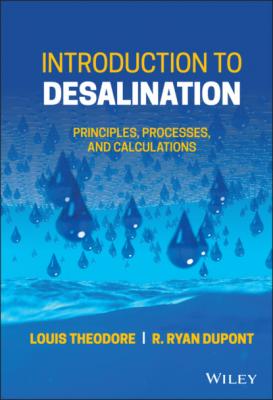Introduction to Desalination. Louis Theodore
Чтение книги онлайн.
Читать онлайн книгу Introduction to Desalination - Louis Theodore страница 27
 while the other number, before and after the comma, will be separated by spaces between groups of three, i.e. one million dollars will be $1 000 000,00. More details are provided in a later section. Details on the seven base units are provided shortly.
while the other number, before and after the comma, will be separated by spaces between groups of three, i.e. one million dollars will be $1 000 000,00. More details are provided in a later section. Details on the seven base units are provided shortly.
3.2.1 Length – Meter (m)
The meter (common international spelling, metre) is defined as 1,670,763.00 wavelengths in vacuum of the orange-red line of the spectrum of krypton-86. The SI unit of area is the square meter (m2). The SI unit of volume is the cubic meter (m3). The liter (0.001 cubic meter), although not an SI unit, is commonly used to measure fluid volume.
3.2.2 Mass – Kilogram (kg)
The standard for the unit of mass, the kilogram, is a cylinder of platinum-iridium alloy kept by the International Bureau of Weights and Measures in Paris. A duplicate in the custody of the National Bureau of Standards serves as the mass standard for the United States. This is the only base unit defined by an artifact. The SI unit of force is the newton (N). One newton is the force which, when applied to a 1 kilogram mass, will give the kilogram mass an acceleration of 1 (meter per second) per second, i.e.
The SI unit for pressure is pascal (Pa). One pascal equals 1 N/m2. The SI unit for work and energy of any kind is the joule (J). One joule is equal to 1 N-m. The SI unit for power of any king is the watt (W). One watt is equal to 1 J/s.
3.2.3 Time – Seconds (s)
The second is defined as the duration of 9,192,632,770 cycles of the radiation associated with a specified transition of the cesium-133 atom. It is realized by tuning an oscillator to the resonance frequency of cesium-133 atoms as they pass through a system of magnets and a resonant cavity into a detector. The number of periods or cycles per second is called frequency. The SI unit for frequency is the hertz (Hz). One hertz equals one cycle/s The SI unit for speed is the meter per second (m/s). The SI unit for acceleration is the meter per second per second (m/s2).
3.2.4 Electrical Current – Ampere (A)
The ampere is defined as that current which, if maintained in each of two long parallel wires separated by 1 meter in free space, would produce a force between the two wires (due to their magnetic fields) of 2 × 10-7 N/m length. The SI unit of voltage is the volt (V), where one volt equals 1 W/A. The unit of electrical resistance is the ohm (Ω). One ohm equals 1 V/A.
3.2.5 Temperature – Kelvin (K)
The Kelvin is defined as the fraction 1/273.15 of the thermodynamic temperature of the triple point of water. The temperature 0 K is called absolute zero. On the commonly used Celsius temperature scale, water freezes at ambient conditions at about 0°C and boils at about 100°C. The C is defined as an interval of 1 K, and the Celsius temperature 0°C is defined as 273.15 K. On the Fahrenheit scale, 1.8°Fahrenheit is equal to 1.0°C or 1.0 K; the Fahrenheit scale uses 32°F as a temperature corresponding to °C.
3.2.6 Amount of a Substance – Mole (mol)
The mole is the amount of substance of a system that contains as many elementary entities as there are atoms and is 0.012 kg of carbon-12. When the mole is used, the elementary entities must be specified and may be atoms, molecules, ions, electrons, other particles, or specified groups of such particles. The SI unit of concentration of a substance is the mole per cubic meter (mol/m3).
3 .2.7 Luminous Intensity – Candela (cd)
The candela is defined as the luminous intensity of 1/600,000 of a square meter of a black body at the temperature of freezing platinum (2045 K). The SI unit of light flux is the lumen (lm). A source having an intensity of 1 candela in all directions radiates a light flux of 4π lumens.
3.2.8 Supplementary Units
Two supplementary units complement these seven primary units. They include:
1 Phase angle – radian (rad). The radian is the plane angle with its vertex at the center of a circle that is subtended by an arc equal in length to the radius.
2 Solid angle – steradian (sr). The steradian is the solid angle with its vertex at the center of a sphere that is subtended by an arc of the spherical surface equal to that with sides equal in length to the radius.
3.3 SI Multiples and Prefixes
Important SI multiples and prefixes are provided in Table 3.1.
Table 3.1 SI multiples and prefixes.
| Multiples submultiples | Prefixes | Symbols | |
|---|---|---|---|
| 1 000 000 000 000 | 1012 | tera | T |
| 1 000 000 000 | 109 | giga | G |
| 1 000 000 | 106 | mega | M |
| 1000 | 103 | kilo | k |
| 100 | 102 | hecto | h |
| 10 | 101 | deka | da |
| Base unit 1 | 100 | ||
| 0.1 | 10-1 | deci | d |
| 0.01 | 10-2 | centi | c |
| 0.001 | 10-3 | milli | m |
| 0.000 001 | 10-6 | micro | µ |
| 0.000 000 001 | 10-9 | nano |